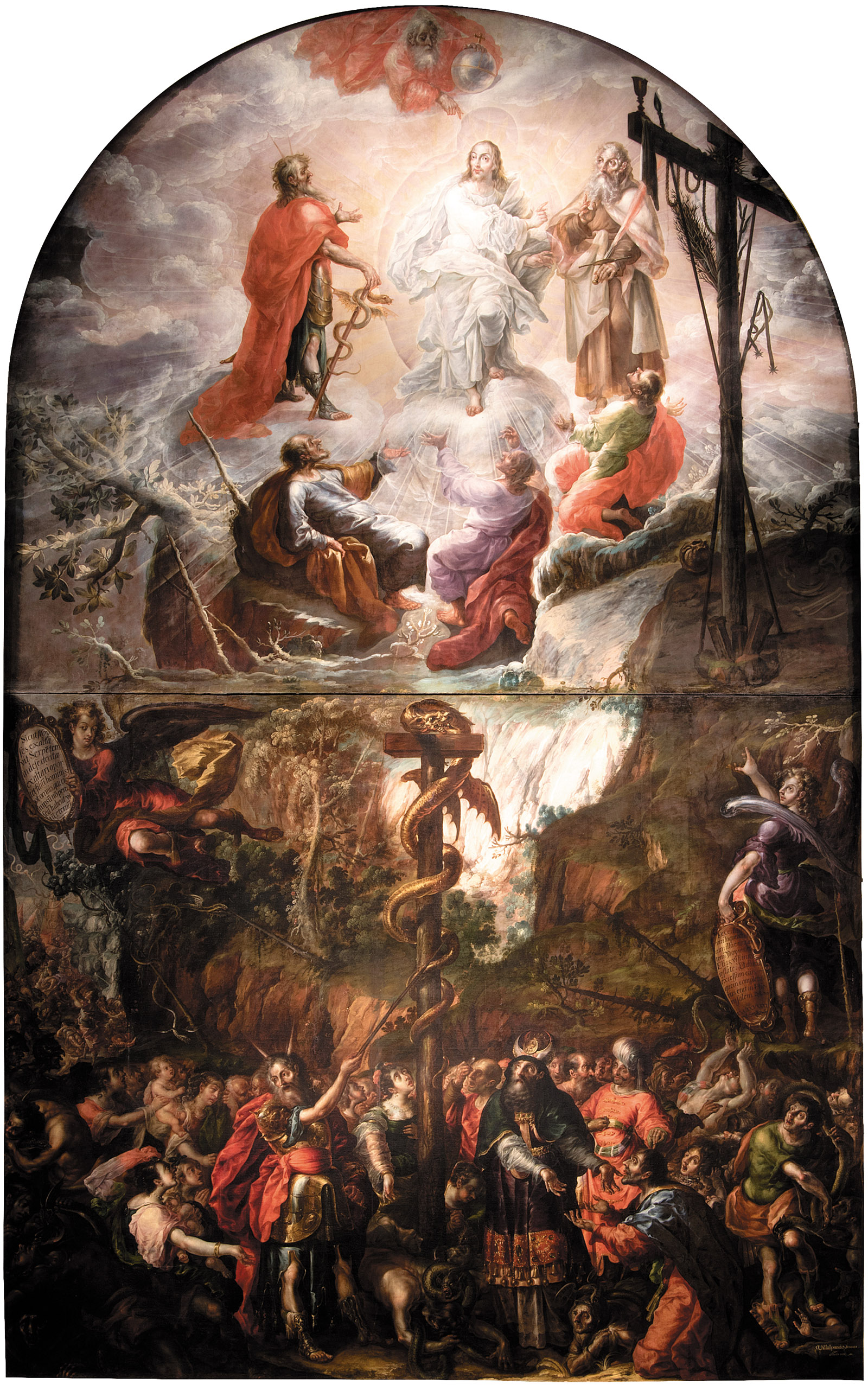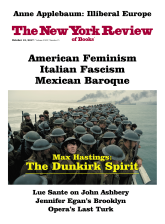Jonathan Brown, in an essay adapted for the catalog of the exhibition of the work of Cristóbal de Villalpando at the Metropolitan Museum, warns us against the use of the word “colonial” in connection with Spanish-American painting of the period 1550–1700. Colonial, he says, “carries the burden of second-class status.” It “implies the domination and subordination of a territory and its inhabitants, who are dependants of the conquerors.” Once you start in this direction,
the path is clear; the final stop becomes “derivative” and thus inferior. “Center” and “periphery” are also insufficient, with their implication of hierarchy. Equally, “hybrid” has its flaws, for the hybrid is set implicitly into opposition to the pure and unadulterated.
So: New Spain (of which Mexico formed a part) was not a colony. It was not dominated by or subordinated to Spain. Its art was in no way derivative or inferior to anything European. Nor was it in any sense hybrid. Although the definition of hybrid—the offspring of two animals or plants of different species—seems not unhelpful when we contemplate, for instance, those rifle-toting angels of the Cuzco school in Peru. They are winged figures of clearly Christian derivation. But they are inconceivable in the setting of any European church. Something else is at work, something very powerful, to give us angels with rifles.
This kind of marked difference is of course what excites us, and what we hope to find in the art of the Mexican baroque. And for my part I feel that it is better, when displaying paintings of this sort, to keep them well apart from European works, as here, to avoid comparison. The experimental, haphazard mixed hang that museums sometimes go in for does them no favors. They are in danger of looking folksy and repetitive and crude. If saying this implies that such works are vulnerable to such juxtaposition, so be it. Paintings are vulnerable. All paintings are. Each needs its own special consideration.
In São Paolo recently I saw an old master collection rehung in a radical way: each work was suspended in mid-air, without the benefit of any wall. The labels were attached to the reverses of the frames. So one could walk past a row of European old masters without reading a single label, guessing at authorship, or one could treat each oil painting as an object with two sides, and think about the qualities of canvas, stretchers, and labels old and new. What was eliminated was what most of the artists involved would have expected to be present: a sense of a stable color-field background.
It seemed a dreadfully cruel way to treat an interesting collection of paintings. One man who would particularly have hated it would have been Degas, who was an extremist in this matter. He loathed seeing that familiar works had been moved to unfamiliar places in the Louvre. He thought paintings in the Louvre should be like altarpieces in a church, each in its permanent allotted place.
It is good to see Cristobal de Villalpando’s huge altarpiece at the Met placed at the very center of the Robert Lehman wing, where it can be admired from two levels, top-lit by daylight. At just over twenty-eight feet high by fourteen feet wide, it benefits from isolation, both from the objects in the Lehman collection and from the small selection of lesser works by Villalpando exhibited in their own gallery nearby. The lower half of the crowded composition depicts Moses raising the Brazen Serpent; the upper, the Transfiguration of Jesus.
What we are not shown is the way it is displayed in its permanent Mexican home (for which it was painted) in Puebla cathedral. The chapel that it dominates was restored in the nineteenth century, so perhaps no one knows exactly what the original interior was like. Its function, however, is clear. A sculpture depicting Christ at the Column had been placed on the altar, and was credited with miraculous cures during one of the epidemics that periodically affected Puebla. Before this altar one was supposed to meditate on the sufferings of Christ (his being scourged at the column prior to crucifixion), to confess one’s sins, and to show contrition, especially during Lent, as a prelude to receiving communion on Easter Sunday. The sacred image was probably not large, for we learn that it was placed behind glass in a niche, and that the column was embellished with silver and a filigree scourge.
The theme of Christ’s suffering was paired with that of God’s wrath, as in the upper and lower parts of Villalpando’s altarpiece. Meditate on the suffering Christ, show contrition, and—as long as the bishop of Puebla allowed it—you might receive His Body and be saved. The bishop “painted with most vivid colors the beauty enjoyed by the soul in a state of grace and the ugliness and horror suffered by the condemned soul.”
Advertisement
This ugliness and horror had been depicted in the Old Testament in the Book of Numbers, where the continual backsliding of the children of Israel is punished in various ways—notably by God’s refusal to allow either Moses or Aaron to enter the Promised Land. God commands Moses on Mount Hor to remove Aaron’s robes and to put them upon his son Eleazar. This results in Aaron’s death on the mountain. There follows a vicious interlude in which God helps the Israelites massacre the Canaanites and destroy their cities. But now the Israelites come to Edom, where they are much discouraged, and complain to Moses: “Wherefore have ye brought us up out of Egypt to die in the wilderness? for there is no bread, neither is there any water; and our soul loatheth this light bread [meaning manna].”
This enrages God, who sends fiery serpents among the people, many of whom die. The Israelites realize they made a mistake in speaking against Jehovah and they ask Moses to intercede on their behalf, whereupon God does something rather unexpected (in a religion that forbids idolatry): he instructs Moses to make a fiery serpent of brass or bronze, which he sets upon the standard. Anyone bitten by one of the snakes has only to look upon this serpent and he is cured.
Quite how this story of a miraculous snake image resonated among a seventeenth-century Mexican congregation (in a land where the snake deity had taken many different forms) can only be guessed. Villalpando lets his imagination rip. The snake is huge and has wings, and it is coiled around the standard, whose form echoes the cross of Christ in the upper register (the depiction of the Transfiguration). Less visible at first are the malignant fiery serpents around the feet of the onlookers, prominent among whom are Moses, in resplendent armor, and a high priest who must be Eleazar, wearing the robes that had been removed from his father.
An angel flies above the Israelites bearing a shield with an inscription from the Gospel according to John: “And as Moses lifted up the serpent in the wilderness, even so must the Son of man be lifted up; that whosoever believeth in him should not perish but have eternal life.” The brazen serpent in the lower register is thus the prefigured Christ of the upper register.
The catalog is lavish in its praise of Villalpando, referring to “the artist’s conscious assimilation of the Flemish impetus of Rubens, incorporated entirely and visibly in his personal language.” This would represent a remarkable achievement for any artist working in Europe and able to study Rubens at first hand. Villalpando, in Puebla, had access only to engravings after Rubens, and he does not benefit from this kind of exaggeration. He borrows one detail in reverse from an engraving of Rubens’s depiction of the same subject: it is the upper torso of a naked woman. But one would not otherwise say that the Flemish master had been consciously assimilated.
An evident unease in the catalog surrounds the question of drawing. We are shown no examples of Mexican baroque drawing by Villalpando or anyone else. We learn, however, that “although Villalpando was trained in the discipline of drawing, it did not take long for him to loosen his brushstroke, freeing it from harsh outlines.” This seems to see drawing as a matter of outline alone, rather than a question of design. The same author later tells us: “In response to weaknesses in drawing, the artist’s conception predominated and became the vital breath that seems to have brought his euphoric brush to life.” But the design of such a painting is the conception. Finally, it is claimed that “Villalpando, who embodied technical expertise and the pure pleasure of painting, represented the purest essence of great Spanish painting”—that after the death of Murillo in 1682 he was the last of the great Spanish baroque painters left working.
This kind of rhetorical recklessness does the subject no service. There must be a path to tread between gross overpraise and prejudicial dismissiveness. There must be a way of acknowledging that one thing can be better than another, that there is no comparison between the skills of Murillo or Zurburán and the crude but fascinating notations of Villalpando—those bulging eyeballs, those repetitive noses, those fiery serpents.
This Issue
October 12, 2017
Splendid Isolation
The Art of Wrath
The Chinese World Order




